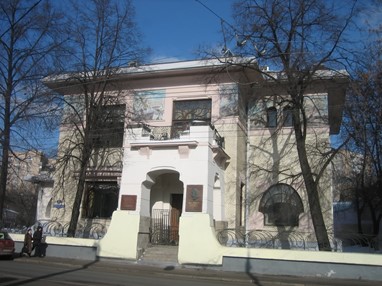Особняк С. П. Рябушинского был построен в 1900-1903 годах архитектором Ф.О. Шехтелем. Он является прекрасным памятником московского модерна.
Интересно, что здание не имеет парадного фасада. Лаконичный двухэтажный особняк выглядит ассиметрично. Большие окна, выступающие подъезды, разноуровневая крыша, горизонтальный карниз - все это в совокупности создает сумбурную картину. Но не смотря на это, архитектура здания выглядит изящно. Это достигается светлой гаммой и продуманностью композиции. Особняк облицован светлой керамической плиткой и украшен мозаичным фризом с изображениями различных растений.
Не менее оригинальны и интерьеры здания. Центральная лестница напоминает волну, выносящую на первый этаж светильник в виде медузы. Потолок гостиной украшен лепниной с изображением полевых и болотных растений, по которым ползут крупные улитки. Капитель колонны второго этажа обвили саламандры и кувшинки. Любопытна старообрядческая молельня, расположенная на потайном третьем этаже. Ее украшает ковровая роспись, в которой соединяются ранневизантийские, древнерусские элементы и модерн.
После революции особняк Рябушинского занял Наркомат иностранных дел, а затем Госиздат, куда приходили Есенин, Маяковский и Брюсов. В 1931 году в здании поселили вернувшегося из Италии Максима Горького. У него в гостях побывали многие известные деятели, среди них - Бухарин, Маршак, Ромен Роллан, Сталин.
Сегодня в особняке устроен мемориальный музей-квартира Горького (вход бесплатный). Здесь можно увидеть личные вещи писателя и коллекцию восточного искусства. И, конечно, полюбоваться прекрасными интерьерами Шехтеля.
В 1942 году в бывших помещениях прислуги на втором этаже флигеля усадьбы поселился писатель А.Н. Толстой. В 1987 году открылся его музей, где сохранились старинная мебель и произведения искусства из личной коллекции писателя.
Как добраться до музея-квартиры Горького (особняка Рябушинского)
Станции метро "Тверская", "Пушкинская", "Чеховская". Выход к Тверскому бульвару. Далее пройти по бульвару до конца и свернуть на право - на Малую Никитскую улицу.
Ryabushinsky’s Mansion (Gorky memorial apartment museum)
S.P. Ryabushinsky’s mansion was built in 1900-1903 upon the project by architect F.O. Shekhtel. It is a remarkable monument of the Moscow modernist style.
Mansion does not have a parade facade and does not lend itself to visual impressions. The mansion is completely asymmetrical. Large windows, powerful protruding entrance volumes, horizontal cornices with multi-tiered roofs, are separately distinct and correctly geometric, but together all elements of the building create a tumultuous picture. Shekhtel’s main work, regardless of its apparent massiveness, is very elegant and architecturally pure, probably because of the light single-tone colour range and deliberate composition. Two-storey building lined with light ceramic tiles and decorated with elegant mosaic friezes depicting diferents plants.
The original interiors of Ryabushinsky’s mansion are such that the central staircase is reminiscent of a wave delivering a lamp that looks like a medusa up to the first floor. The lounge’s ceiling is decorated with stucco depictions of field and marsh plants being crawled over by large snails, while salamanders and lilies wind around the chapiter of the column on the second floor. On the secret third floor, there is an Old Believers’ prayer room. It is decorated with a carpet in neo-Russian style that links early Byzantine and ancient Russian elements with the modernist style.
After the revolution, the building housed the People’s Committee of Foreign Affairs, then for some time the mansion was home to the Main Administration of the State Publishing House (“Gosizdat”), which was visited by the poets Yesenin, Mayakovsky and Bryusov. In 1931, Maksim Gorky returned to the USSR from Italy and stayed in Ryabushinsky’s estate. Gorky has many guests including Nikolai Bukharin, Samuil Marshak, Romain Rolland and Iosif Stalin.
Today, in the Ryabushinsky''s mansion is a Gorky memorial apartment museum in the mansion (free entry). There is a curious collection of eastern art and personal affects of the writer, however the exhibition’s main display remains Shekthel’s grand interiors.
In 1942, Aleksei Tolstoy the author of the novels “Peter I” and “The Road to Calvary” was housed in the former servants’ quarters on the second floor of the Ryabushinskys’ wing. A museum to the writer opened in 1987. Old furniture and individual works of art from Tolstoy’s personal collection have been preserved in the rooms.
How to get to Ryabushinsky’s Mansion (Gorky memorial apartment museum)
Metro stations are "Tverskaya", "Pushkinskaya", "Chehovskaya". Exit to Tverskoy boulevard. Go straight to the end of boulevard and turn right on the Malaya Nikitskaya street.
Adress is 6 Malaya Nikitskaya Street


